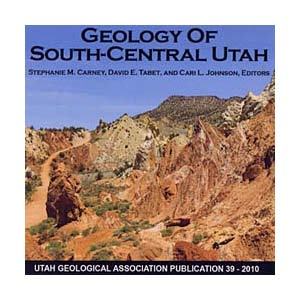Variations in iron oxide, iron sulphide and carbonate concretions and their distributions in fluvio-deltaic and nearshore sandstones: cretaceous examples from the Kaiparowits Plateau, Utah and San Juan Basin, New Mexico
Roberts, Eric M., and Chan, Marjorie A. (2010) Variations in iron oxide, iron sulphide and carbonate concretions and their distributions in fluvio-deltaic and nearshore sandstones: cretaceous examples from the Kaiparowits Plateau, Utah and San Juan Basin, New Mexico. In: Carney, Stephanie M., Tabet, David E., and Johnson, Carl L., (eds.) Geology of South Central Utah. Utah Geological Association Publication (39). Utah Geological Association, Salt Lake City, UT, USA, pp. 151-177.
![[img]](https://researchonline.jcu.edu.au/16328/1.hassmallThumbnailVersion/16328_Roberts_and_Chan_2010.jpg)
|
Image (JPEG) (Book Cover)
- Cover Image
Download (24kB) |
|
|
PDF (Published Version)
- Published Version
Restricted to Repository staff only |
Abstract
Iron oxide, iron sulfide, and carbonate concretions are potential tools for understanding groundwater movement and flow pathways, and for aiding diagenetic reconstruction ofheterogeneous Upper Cretaceous fluvio-de1taic, estuarine, and nearshore strata on the Kaiparowits Plateau, Utah and in the San Juan Basin, New Mexico. Hand sample analysis, paleocurrent measurements, transmitted and reflected light microscopy, reflectance spectroscopy, and x-ray diffraction were used to identify the chemistry, mineralogy and genesis of these concretions. Examples from the Kaiparowits Plateau are complex, displaying a range of morphologies and mineralogies, including hematite and pyrite spheroidal forms and ferricretes, small to enormous carbonate (calcite, dolomite and minor siderite) spheres, and oriented, elongated tubes, pipes and botryoidal clusters. The oriented, elongated concretion varieties are concentrated between the 450 to 600 m level in the Kaiparowits Formation and show a strong preferential NW-SE alignment (148-328'). Taken together, these data suggest that carbonate concretionary development was strongly influenced by a major lithological boundary in the Kaiparowits Formation, as groundwater flowed downwards through highly permeable sandstones of the upper member (sandstone:mudstone ratio = 75:25) and into less permeable, more heterogenous strata of the middle member (sandstone:mudstone ratio = 60:40). As phreatic groundwater flow was forced horizontally, due to increasing heterogeneity and reduced permeability, it was concentrated in the most porous and permeable channel sandstones, where concretion development preferentially took place. Moreover, the strong preferred concretion alignment to the NW-SE is parallel to the axis of the Laramide-aged Table Cliff syncline, suggesting that concretion formation took place at least 10 million years after deposition of the Kaiparowits Formation, sometime after development of the Table Cliff syncline. In contrast, spheroidal pyrite concretions on the Kaiparowits Plateau represent a completely different origin, resulting from early diagenesis associated with swampy, waterlogged fluvio-estuarine depositional conditions and availability of abundant vegetation in reducing environments.
The Chaco Canyon examples display a range of well-preserved iron oxide concretions that include hematite-cemented trace fossils, small spheroidal concretionary forms, as well as large ("cannon-ball-sized") spherical concretions. In each of these examples, as well as in some Kaiparowits examples, pyrite plays a significant role as a precursor mineral, with later oxidation to iron-oxide mineralogies. The presence of pyrite is attributed to deltaic and estuarine environments with reducing conditions, and presence of sulfur related to the carbonaceous or coal-bearing units. In contrast, the carbonate concretions are more consistent with late-stage diagenesis, associated with phreatic pore waters.
This study provides a better understanding of concretion development in Upper Cretaceous sandstones of the Western Interior Basin. Recognition and analysis of concretions and other features (e.g., preferential cementation of burrows and alignment of concretions) play an important role in reconstructing depositional environments and geochemistry at the time of deposition and concretion formation, in addition to providing novel data for reconstructing regional hydrologic events, including tectonic uplift and changes in drainage and groundwater flow evolution.
| Item ID: | 16328 |
|---|---|
| Item Type: | Book Chapter (Non-Commercial) |
| ISBN: | 978-0-9800489-2-6 |
| Related URLs: | |
| Date Deposited: | 30 Jan 2013 02:46 |
| FoR Codes: | 04 EARTH SCIENCES > 0403 Geology > 040310 Sedimentology @ 100% |
| SEO Codes: | 97 EXPANDING KNOWLEDGE > 970104 Expanding Knowledge in the Earth Sciences @ 100% |
| Downloads: |
Total: 447 Last 12 Months: 7 |
| More Statistics |



